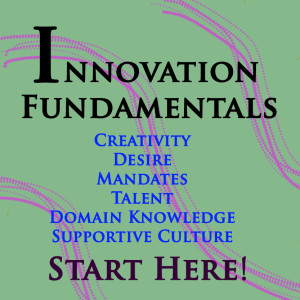 Innovation Fundamentals for Leaders
Innovation Fundamentals for Leaders
First of Seven Blogs
Invest in Frameworks, But First, Establish a Culture Where Innovation Thrives
Leaders — How Are You Doing With These Basics?
Success is built on doing the basics well. For results, leaders need to foster innovation fundamentals and integrate them into organizational culture. More structure is needed as fundamentals take hold, and that means an innovation process framework. This series of posts on innovation fundamentals is not about frameworks. It’s about the cultural basics underlying them, and all innovation.
Innovation has a lot of frameworks (and theories, methods, tools) that leaders can choose from, and you’ll want to choose. However, frameworks have built-in assumptions, such as, there’s motivation to innovate, and that the culture is aligned with an innovation effort. Frameworks assume: engaged leadership, talent on the team, day to day creativity, curiosity, and domain knowledge. Frameworks fail when leaders don’t have these cultural basics squared away.
You will fail with: Lean, Agile, Design Thinking, TRIZ, Stage-Gate, Osborn-Parnes CPS, KILN’s FuseTrail, or a homegrown/blended framework. With fundamentals in place, you’ve got a chance, even without a formal process.
Innovation leaders, review this list and get a sense of where you are with the fundamentals. If you know you’re falling short, stay tuned for remedy posts (or call/write).
Seven Innovation Fundamentals:
- Applying creative thinking to problems. There is no innovation without creativity. Individuals and teams need to be creative in order to solve focused innovation challenges. Creativity, and creative ideas, are essential ingredients, and, without other fundamentals, like projects and implementation — great ideas are a waste of time. Still, curiosity, freedom of expression, and creative thinking are essential to success.
- An authentic desire to improve or invent. This company-wide desire must be sustained through hard work and intimidating obstacles. This takes an understanding of why you innovate, and, it takes leadership to communicate and focus the desire. Desire is a tough thing to manufacture from scratch. That said, desire can be “found” if you make people aware of the stakes of the innovation game, and give them a vehicle to perform. The more people that have a genuine desire to innovate, the better off you are.
- A mandate to innovate. Oganization’s, and teams inside them, need a mandate to innovate. Call it authorization coupled with focus, but it must be clear there is approval to innovate. The mandate should include a skeleton process of checking-in and pitches at the end of the mini-process. If you’re not the boss, ask for a mandate, and keep asking. Yes, there are positive stories of teams who created sneaky, aka “skunk works” innovation. The stories not told are the teams who worked without a mandate — created something interesting, and then got squashed, fired, or disbanded. If you’re a leader, create the mandate, and get a diverse team organized to carry it out, in Projects.
- You must have Talent. Working hard, and smart, makes a difference, so does persistence, and domain knowledge. But you can have all those factors right, and still fail. Someone needs a spark of superior inventive talent, or you won’t have the quality ideas you need to succeed. It depends on your business, but having superior talent on board is necessary. If you know in your heart that you don’t have that thinker on your team, find them, hire them. Or, become a fast follower and add value to the genius of others. Talented people are hiding in your midst, look carefully, they are often disguised as introverts — develop them.
- Domain Knowledge, understanding your area and market, deeply. The science and the technology, and, the ever-changing market and customers. Even better, you’ve identified a missing, or a problem nobody else has figured out yet. Customers can inform you, and by all means listen carefully, do your research homework. However, customers often don’t know what they need or want. Design Thinking puts an emphasis on this exploration, it’s a fundamental built into their framework, excellent! Exploration, done in many sorts of ways, is an innovation fundamental.
- Culture is key. Think about the vibe or overall morale of your organization. Is it positive? Fun? Interesting? A negative, cynical culture is a red flag for innovation. If you’re a leader, your role is establishing a positive supportive culture. How you do that, in detail, is another blog post, but suffice to say, if people aren’t having any fun, you’re not doing it right. Leaders need to get involved, set an example, provide a mandate, and support a continuous cycle of innovation efforts. Encourage pitches, ask for ideas, take action, provide resources.
- Projects change culture. Projects are essential. If you’re doing projects for innovation, you’ve got a chance. You can stumble and fall, screw up, etc. but projects teach you. The process of doing projects changes cultures. If you don’t have a cycle of projects going on, you’re not innovating. One genius engineer over in the corner might create something amazing, but to get that thing to market, you need a team, and a system of innovation that includes an on-going cycle of projects. How you do a project is what a framework is all about. If you’re completing innovation projects now, you have a framework!
How does your organization stack up? If you have the sense you’re not on track, consider assessments, awareness building, and training as starting points — all on your way to, or as part of, Projects. If you want to kick start an innovation program, get in touch, I can give you a roadmap and help you adapt it to your context.
This series of Seven Innovation Fundamentals is available as a training, workshop, or as a keynote speech, from Gregg Fraley of GFi.


